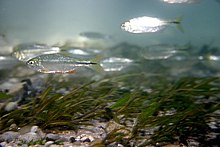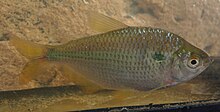Astyanax (fish)
| Astyanax | |
|---|---|

| |
| Astyanax mexicanus | |
| Scientific classification | |
| Domain: | Eukaryota |
| Kingdom: | Animalia |
| Phylum: | Chordata |
| Class: | Actinopterygii |
| Order: | Characiformes |
| Family: | Characidae |
| Subfamily: | incertae sedis |
| Genus: | Astyanax S. F. Baird & Girard, 1854 |
| Type species | |
| Astyanax argentatus Baird & Girard, 1854 | |
| Synonyms | |
|
Anoptichthys Hubbs & Innes, 1936 | |
Astyanax is a genus of freshwater fish in the family Characidae of the order Characiformes. Some of these fish, like many of their relatives, are kept as aquarium pets and known collectively as tetras. With around 150 described species and new ones being described yearly,[2] this genus is among the largest of the entire order; Hyphessobrycon also has more than 145 species and which one is larger at any one time depends on whether more species have been recently described in one or the other. The blind and colorless cave tetra of Mexico is a famous member of the genus, but its taxonomic position is disputed: Some recognize it as part of the Mexican tetra (A. mexicanus) and this is supported by phylogenetic evidence,[3][4][5][6][7] but others recognize the cave form as a separate species, A. jordani.[2]
The type species is A. argentatus, now regarded as a form of the Mexican tetra (A. mexicanus). The generic name comes from Astyanax, a character in Greek mythology, who was the son of Hector of Troy; in homage to this, several specific epithets also refer to the Iliad.[2]
Taxonomy and systematics
This genus is more or less defined as in 1917 by Carl H. Eigenmann. The lack of comprehensive phylogenetic analyses dealing with this genus is hindering a thorough review and the relationships remain as indeterminate as the monophyly is doubtful. The results of 2020 study using a combination of molecular and morphological data appeared to confirm that Astyanax is not monophyletic and suggested the creation of two new genera and the resurrection of Psalidodon.[8] Although included in Astyanax by FishBase, phylogenetic evidence supports moving A. aurocaudatus back to the monotypic genus Carlastyanax.[9]
Species









There are currently 132 recognized species in this genus:
- Astyanax abramis (L. Jenyns, 1842)[10]
- Astyanax acatlanensis Schmitter-Soto, 2017
- Astyanax aeneus (Günther, 1860) (Banded tetra)
- Astyanax altior C. L. Hubbs, 1936 (Yucatán tetra)
- Astyanax altiparanae Garutti & Britski, 2000
- Astyanax anai Angulo, Santos, López, Langeani & McMahan, 2018
- Astyanax angustifrons (Regan, 1908)
- Astyanax apiaka Ferreira, F. C. T. Lima, Ribeiro, Junior, F. A. Machado & Mirande, 2023
- Astyanax aramburui Protogino, Miquelarena & H. L. López, 2006
- Astyanax argentatus Baird & Girard, 1854 (Texan tetra)
- Astyanax argyrimarginatus Garutti, 1999
- Astyanax asuncionensis Géry, 1972
- Astyanax atratoensis C. H. Eigenmann, 1907
- Astyanax aurocaudatus C. H. Eigenmann, 1913
- Astyanax bacalarensis Schmitter-Soto, 2017
- Astyanax bagual Bertaco & Vigo, 2015[11]
- Astyanax baileyi (D. E. Rosen, 1972)[1]
- Astyanax belizianus (Bocourt, 1868) (Belizean tetra)
- Astyanax bimaculatus (Linnaeus, 1758) (Two-spot tetra)
- Astyanax biotae R. M. C. Castro & Vari, 2004
- Astyanax boliviensis Ruiz-C., Román-Valencia, Taphorn, Buckup & Ortega, 2018
- Astyanax bourgeti C. H. Eigenmann, 1908
- Astyanax brachypterygium Bertaco & L. R. Malabarba, 2001
- Astyanax bransfordii (T. N. Gill, 1877)[1]
- Astyanax brevimanus (Günther, 1864) (Quiché tetra)
- Astyanax brevirhinus C. H. Eigenmann, 1908
- Astyanax caballeroi (Contreras-Balderas & Rivera-Tiellery, 1985)[1]
- Astyanax caucanus (Steindachner, 1879)
- Astyanax chaparae Fowler, 1943
- Astyanax clavitaeniatus Garutti, 2003
- Astyanax cocibolca W. A. Bussing, 2008
- Astyanax cordovae (Günther, 1880)
- Astyanax courensis Bertaco, F. R. de Carvalho & Jerep, 2010
- Astyanax cremnobates Bertaco & L. R. Malabarba, 2001
- Astyanax cubilhuitz Schmitter-Soto, 2017
- Astyanax depressirostris A. Miranda-Ribeiro, 1908
- Astyanax dissimilis Garavello & F. A. A. Sampaio, 2010[12]
- Astyanax dnophos F. C. T. Lima & Zuanon, 2004
- Astyanax dorioni (D. E. Rosen, 1970)[1]
- Astyanax douradilho Bertaco, 2014[13]
- Astyanax elachylepis Bertaco & P. H. F. Lucinda, 2005
- Astyanax embera Ruiz-C., Román-Valencia, Taphorn, Buckup & Ortega, 2018
- Astyanax epiagos Zanata & Camelier, 2008
- Astyanax eremus Ingenito & Duboc, 2014[14]
- Astyanax fasslii (Steindachner, 1915)
- Astyanax filiferus (C. H. Eigenmann, 1913)
- Astyanax finitimus (Bocourt, 1868) (Veracruz tetra)
- Astyanax gandhiae Ruiz-C., Román-Valencia, Taphorn, Buckup & Ortega, 2018
- Astyanax gisleni Dahl, 1943
- Astyanax goyacensis C. H. Eigenmann, 1908
- Astyanax goyanensis (P. Miranda-Ribeiro, 1944)
- Astyanax gracilior C. H. Eigenmann, 1908
- Astyanax guaricana C. A. M. Oliveira, Abilhoa & Pavanelli, 2013[15]
- Astyanax henseli F. A. G. Melo & Buckup, 2006
- Astyanax integer G. S. Myers, 1930
- Astyanax jacobinae Zanata & Camelier, 2008 (Piaba)
- Astyanax jacuhiensis (Cope, 1894)
- Astyanax jenynsii (C. H. Eigenmann, 1877)
- Astyanax joaovitori Oliveira, Pavanelli & Bertaco, 2017
- Astyanax jordanensis Vera Alcaraz, Pavanelli & Bertaco, 2009
- Astyanax jordani (C. L. Hubbs & Innes, 1936)
- Astyanax kennedyi Géry, 1964
- Astyanax keronolepis Silva, Malabarba & Malabarba, 2019
- Astyanax kompi Hildebrand, 1938
- Astyanax kullanderi W. J. E. M. Costa, 1995
- Astyanax lacustris (Lütken, 1875)[10]
- Astyanax laticeps (Cope, 1894)
- Astyanax leopoldi Géry, Planquette & Le Bail, 1988
- Astyanax lineatus (Perugia, 1891)
- Astyanax longior (Cope, 1878)
- Astyanax longirhinus Garavello & F. A. A. Sampaio, 2010[12]
- Astyanax macal Schmitter-Soto, 2017
- Astyanax maculisquamis Garutti & Britski, 1997
- Astyanax magdalenae C. H. Eigenmann & Henn, 1916
- Astyanax maximus (Steindachner, 1876)
- Astyanax megaspilura Fowler, 1944
- Astyanax mexicanus (De Filippi, 1853) (Mexican tetra)
- Astyanax microlepis C. H. Eigenmann, 1913
- Astyanax microschemos Bertaco & C. A. S. Lucena, 2006
- Astyanax minor Garavello & F. A. A. Sampaio, 2010[12]
- Astyanax moorii (Boulenger, 1892)
- Astyanax multidens C. H. Eigenmann, 1908
- Astyanax myersi (Fernández-Yépez, 1950)
- Astyanax nasutus Meek, 1907
- Astyanax nicaraguensis C. H. Eigenmann & Ogle, 1907
- Astyanax novae C. H. Eigenmann, 1911[16]
- Astyanax obscurus (R. F. Hensel, 1870)
- Astyanax ocotal Valdez-Moreno, Rodiles-Hernández & Schmitter-Soto, 2017
- Astyanax orbignyanus (Valenciennes, 1850)
- Astyanax orstedii (Lütken, 1875)
- Astyanax orthodus C. H. Eigenmann, 1907
- Astyanax panamensis Günther, 1864[1] (Panamanian tetra)
- Astyanax paraguayensis (Fowler, 1918)
- Astyanax paranahybae C. H. Eigenmann, 1911
- Astyanax pardensis Salgado, 2021
- Astyanax pedri (Eigenmann, 1908)
- Astyanax petenensis (Günther, 1864) (Petén tetra)
- Astyanax pirabitira C. A. S. Lucena, Bertaco & Berbigier, 2013[17]
- Astyanax pirapuan Tagliacollo, Britzke, G. S. C. Silva & Benine, 2011[18]
- Astyanax poetzschkei C. G. E. Ahl, 1932
- Astyanax procerus C. A. S. Lucena, J. B. Castro & Bertaco, 2013[19]
- Astyanax rioverde Lozano-Vilano & Schmitter-Soto, 2017
- Astyanax robustus Meek, 1912
- Astyanax ruberrimus C. H. Eigenmann, 1913
- Astyanax rupununi Fowler, 1914
- Astyanax saltor Travassos, 1960
- Astyanax salvatoris Valdez-Moreno, Lozano-Vilano & Schmitter-Soto, 2017
- Astyanax scabripinnis (L. Jenyns, 1842)
- Astyanax scintillans G. S. Myers, 1928
- Astyanax serratus Garavello & F. A. A. Sampaio, 2010[12]
- Astyanax siapae Garutti, 2003
- Astyanax stilbe (Cope, 1870)
- Astyanax superbus G. S. Myers, 1942
- Astyanax symmetricus C. H. Eigenmann, 1908
- Astyanax tamiahua Schmitter-Soto, 2017
- Astyanax tehuacanensis Schmitter-Soto, 2017
- Astyanax totae Ferreira Haluch & Abilhoa, 2005
- Astyanax trierythropterus Godoy (pt), 1970
- Astyanax turmalinensis Triques, Vono & Caiafa, 2003
- Astyanax unitaeniatus Garutti, 1998
- Astyanax utiariti Bertaco & Garutti, 2007
- Astyanax validus Géry, Planquette & Le Bail, 1991
- Astyanax varzeae Abilhoa & Duboc, 2007
- Astyanax venezuelae L. P. Schultz, 1944
- Astyanax vermilion Zanata & Camelier, 2009
- Astyanax villwocki Zarske & Géry, 1999
- Astyanax yariguies (Torres-Mejia, Hernández & Senechal, 2012)
References
- ^ a b c d e f Schmitter-Soto, Juan J. (2016). "A phylogeny of Astyanax (Characiformes: Characidae) in Central and North America". Zootaxa. 4109 (2): 101–130. doi:10.11646/zootaxa.4109.2.1. PMID 27394856.
- ^ a b c Froese, Rainer; Pauly, Daniel (eds.). "Species in genus Astyanax". FishBase. October 2016 version.
- ^ Jeffery W (2009). "Regressive evolution in Astyanax cavefish". Annu. Rev. Genet. 43: 25–47. doi:10.1146/annurev-genet-102108-134216. PMC 3594788. PMID 19640230.
- ^ Dowling TE, Martasian DP, Jeffery WR (2002). "Evidence for multiple genetic forms with similar eyeless phenotypes in the blind cavefish, Astyanax mexicanus". Mol. Biol. Evol. 19 (4): 446–455. doi:10.1093/oxfordjournals.molbev.a004100. PMID 11919286.
- ^ Bradic, Martina; Beerli, Peter; García-de León, Francisco J; Esquivel-Bobadilla, Sarai; Borowsky, Richard L (2012). "Gene flow and population structure in the Mexican blind cavefish complex (Astyanax mexicanus)". BMC Evolutionary Biology. 12 (1): 9. doi:10.1186/1471-2148-12-9. PMC 3282648. PMID 22269119.
- ^ Strecker U, Faúndez VH, Wilkens H (2004). "Phylogeography of surface and cave Astyanax (Teleostei) from Central and North America based on cytochrome b sequence data". Mol. Phylogenet. Evol. 33 (2): 469–481. doi:10.1016/j.ympev.2004.07.001. PMID 15336680.
- ^ Keene; Yoshizawa; McGaugh (2016). Biology and Evolution of the Mexican Cavefish. Elsevier Science. pp. 77–87. ISBN 978-0-12-802148-4.
- ^ Guillermo E. Terán; Mauricio F. Benitez; J. Marcos Mirande (2020). "Opening the Trojan horse: phylogeny of Astyanax, two new genera and resurrection of Psalidodon (Teleostei: Characidae)". Zoological Journal of the Linnean Society. 190 (4): 1217–1234. doi:10.1093/zoolinnean/zlaa019.
- ^ Mirande JM, Jerep FC, Vanegas-Ríos JA (2013). "Phylogenetic relationships of the enigmatic Carlastyanax aurocaudatus (Eigenmann) with remarks on the phylogeny of the Stevardiinae (Teleostei: Characidae)". Neotropical Ichthyology. 11 (4): 747–766. doi:10.1590/s1679-62252013000400003. hdl:11336/3444.
- ^ a b Lucena CA, Soares HG (2016). "Review of species of the Astyanax bimaculatus "caudal peduncle spot" subgroup sensu Garutti & Langeani (Characiformes, Characidae) from the rio La Plata and rio São Francisco drainages and coastal systems of southern Brazil and Uruguay". Zootaxa. 4072 (1): 101–125. doi:10.11646/zootaxa.4072.1.5. PMID 27395912.
- ^ Bertaco VA, Vigo AC (2015). "A new species of Astyanax Baird & Girard (Ostariophysi: Characidae) from the rio Taquari-Antas basin, southern Brazil" (PDF). Neotropical Ichthyology. 13 (2): 265–272. doi:10.1590/1982-0224-20140145.
- ^ a b c d Garavello, J.C.; Sampaio, F.A.A. (2010). "Five new species of genus Astyanax Baird & Girard, 1854 from Rio Iguaçu, Paraná, Brazil (Ostariophysi, Characiformes, Characidae)" (PDF). Brazilian Journal of Biology. 70 (3): 847–865. doi:10.1590/s1519-69842010000400016. PMID 21085790.
- ^ Bertaco, V.A. (2014). "Astyanax douradilho, a new characid fish from the rio Tramandaí system, southern Brazil (Characiformes: Characidae)" (PDF). Zootaxa. 3794 (3): 492–500. doi:10.11646/zootaxa.3794.3.10. PMID 24870337. Archived from the original (PDF) on 2016-10-05. Retrieved 2016-07-25.
- ^ Ingenito, L.F.S.; Duboc, L.F. (2014). "A new species of Astyanax (Ostariophysi: Characiformes: Characidae) from the upper rio Iguaçu basin, southern Brazil". Neotropical Ichthyology. 12 (2): 281–290. doi:10.1590/1982-0224-20130117.
- ^ Oliveira CA, Abilhoa V, Pavanelli CS (2013). "Astyanax guaricana (Ostariophysi: Characidae), a new species from the rio Cubatão drainage, Paraná State, Southern Brazil". Neotropical Ichthyology. 11 (2): 291–296. doi:10.1590/s1679-62252013000200007.
- ^ Freitas MR, Lucinda PH, Lucena CA (2015). "Redescription of Astyanax novae Eigenmann, 1911 (Teleostei: Characidae)". Ichthyological Exploration of Freshwaters. 26 (2): 183–192.
- ^ Lucena CA, Bertaco VA, Berbigier G (2013). "A new species of Astyanax from headwater streams of southern Brazil (Characiformes: Characidae)". Zootaxa. 3700 (2): 226–236. doi:10.11646/zootaxa.3700.2.2. PMID 26106724.
- ^ Tagliacollo VA, Britzke R, Silva GS, Benine RC (2011). "Astyanax pirapuan: a new characid species from the upper Rio Paraguay system, Mato Grosso, Central Brazil (Characiformes, Characidae)" (PDF). Zootaxa. 2749: 40–46. doi:10.11646/zootaxa.2749.1.3. hdl:11449/41580.
- ^ Lucena CA, Castro JB, Bertaco VA (2013). "Three new species of Astyanax from drainages of southern Brazil (Characiformes: Characidae)". Neotropical Ichthyology. 11 (3): 537–552. doi:10.1590/s1679-62252013000300007.
